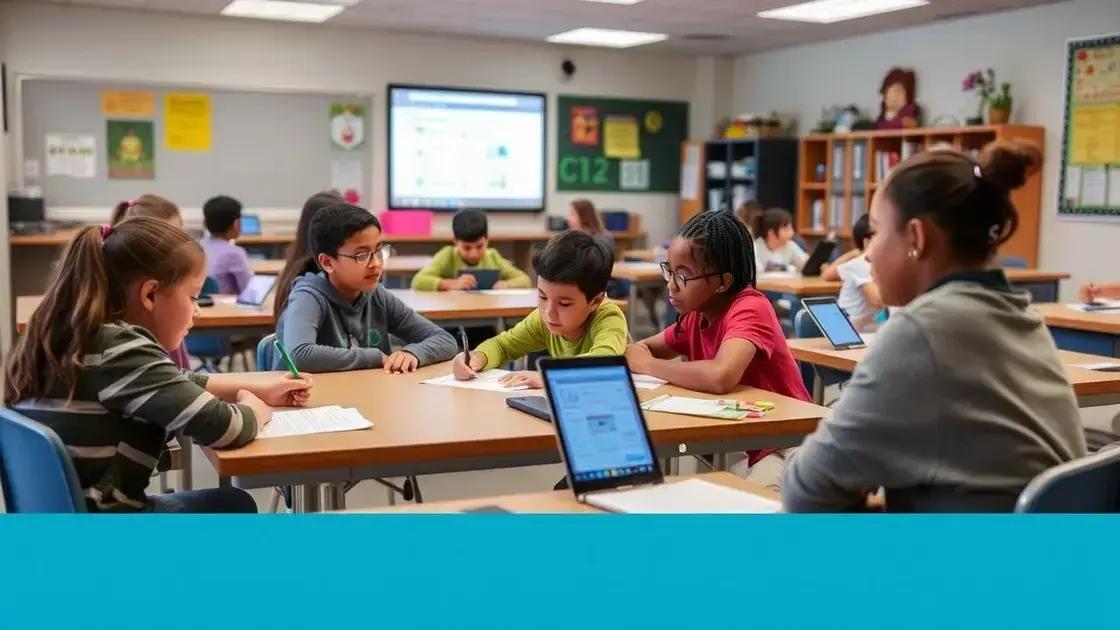AI in classrooms: how technology transforms education

Anúncios
AI in classrooms enhances personalized learning, supports teachers by automating tasks, and provides engaging tools, but also faces challenges in infrastructure, data privacy, and the need for proper training.
AI in classrooms is rapidly changing the way students learn and teachers instruct. Have you ever wondered how technology can create more engaging educational experiences? In this article, we’ll delve into the ways AI is reshaping our approach to learning.
Anúncios
Understanding AI in education
Understanding AI in education is crucial as we embrace new learning methodologies. Artificial Intelligence holds the potential to revolutionize classrooms, making learning more accessible and personalized for students.
What is AI in Education?
Artificial Intelligence refers to systems that mimic human intelligence. In education, it involves using technology to enhance learning experiences. Imagine a classroom where each student has a personalized learning assistant. This can help them grasp concepts at their own pace.
Types of AI Tools
AI tools come in various forms, catering to different educational needs. Some impacts include:
Anúncios
- Adaptive Learning Platforms: These programs adjust to the individual learning speed of students.
- Virtual Tutors: They provide instant feedback and help students with their studies.
- Data Analysis Tools: Educators can track student progress and identify areas needing attention.
By utilizing these tools, educators can create engaging environments that ignite a love for learning.
Why is Understanding AI Important?
As technology evolves, understanding AI in classrooms becomes essential for educators and students alike. Educators who recognize how AI can enhance their teaching will be better equipped to support their students. With AI, lessons can be more interactive and tailored to meet every student’s unique needs.
Additionally, students equipped with AI knowledge will have a competitive advantage in their futures. They will learn to interact with technology positively and productively.
Benefits of AI tools in classrooms
The benefits of AI tools in classrooms are significant, providing both teachers and students with amazing opportunities. With the right applications, education can become more effective and enjoyable.
Personalized Learning
One major advantage of AI in education is the ability to offer personalized learning experiences. AI systems can adapt to individual learning speeds, helping students who might struggle in traditional settings.
By using algorithms, these tools can assess a student’s progress and adjust the learning materials accordingly. This ensures that every student receives the right support at the right time, enhancing their education.
Enhanced Engagement
AI tools, such as interactive software and educational games, make learning much more engaging. With tools like virtual reality classrooms, students can dive into immersive learning scenarios, which are both fun and educational.
- Interactive Lessons: AI can help create lessons that respond to student input, making learning dynamic.
- Motivating Tools: Gamification encourages students to participate by earning rewards for completing tasks.
- Visual Learning: AI helps turn complex ideas into visuals, making them easier to understand.
These engaging methods can cultivate a genuine interest in learning that traditional methods might not achieve.
Efficient Administrative Tasks
Teachers often spend a lot of time on administrative tasks. AI tools can help automate these processes, allowing educators to focus more on teaching and interacting with students.
By streamlining tasks such as grading and attendance tracking, teachers can invest their time in developing creative lesson plans and giving personalized feedback to students.
Ultimately, by enhancing teaching methods and minimizing time spent on paperwork, AI tools lead to an improved learning environment.
Challenges of integrating AI in schools

Integrating AI in schools presents various challenges, even though the benefits can be significant. Schools need to carefully consider these difficulties to successfully implement AI technologies.
Infrastructure Limitations
One of the primary challenges is the existing infrastructure in many schools. Outdated technology can hinder the effective use of AI tools. Without the necessary hardware, students and teachers cannot fully benefit from AI innovations.
Schools often need to invest in new computers, software, and network capabilities to support AI applications. This can strain budgets and limit accessibility for some institutions.
Training and Support
Proper training for teachers is crucial when integrating AI into classrooms. Educators must understand how to use these tools effectively and adapt their teaching methods. Without adequate training, teachers may feel overwhelmed and unable to implement AI solutions confidently.
Support resources are also necessary to help teachers troubleshoot issues and answer questions as they arise. To enhance the learning environment, schools need to provide ongoing professional development focused on AI and technology.
Data Privacy and Security
Using AI often involves collecting and analyzing student data. This raises concerns about data privacy and security. Schools must ensure that data is handled responsibly and ethically, protecting students’ personal information.
Clear policies and practices should be in place to manage data securely, preventing breaches while using AI tools for educational purposes.
Overall, addressing these challenges is vital for schools aiming to embrace AI technology sustainably and effectively.
Real-life examples of AI in education
Real-life examples of AI in education provide insight into how technology enhances the learning environment. Various institutions are successfully implementing AI tools to improve teaching and learning.
Personalized Learning Platforms
Many schools utilize personalized learning platforms powered by AI. For instance, programs like DreamBox Learning adjust math lessons based on each student’s performance. This tailored approach helps students learn at their own pace, ensuring they grasp essential concepts before moving forward.
Intelligent Tutoring Systems
Intelligent tutoring systems, such as Carnegie Learning, offer students additional support outside the classroom. These tools provide step-by-step guidance and personalized feedback, helping students understand their mistakes and learn from them.
- Real-time Feedback: Students receive instant assessments, allowing them to improve immediately.
- Support for Teachers: Educators can track progress and identify areas where students may need extra help.
- Engagement: Interactive lessons keep students interested and motivated.
By integrating such tools, schools can enhance student performance while alleviating some workload from teachers.
AI in Administrative Tasks
AI is also used in administrative roles within schools to create efficiencies. For example, tools like RoboGrader automate grading processes, saving educators valuable time. These systems help deliver consistent feedback on assessments, letting teachers focus on teaching rather than paperwork.
In addition, AI can analyze data to help educational leaders make informed decisions about curriculum and resource allocation. These data-driven insights can lead to more effective teaching strategies and better educational outcomes for students.
The future of AI in classrooms
The future of AI in classrooms looks promising, with technology set to further transform education. As AI tools evolve, they will play an even larger role in shaping how students learn and engage with content.
Advanced Personalization
In the coming years, AI will provide more advanced personalization for students. This means learning experiences will be even more tailored to individual needs. With algorithms becoming smarter, AI will analyze student data to offer customized resources and activities.
Collaboration with Educators
AI will serve as valuable support for teachers, allowing them to focus on instruction and student interaction. Imagine AI systems helping teachers plan lessons by suggesting relevant resources and strategies. These systems will assist in grading and track student progress, ensuring teachers can dedicate time to encouraging engagement and creativity.
- Smart Classrooms: Classrooms will have interactive whiteboards and AI-driven tools that provide real-time feedback to students.
- Virtual Reality: AI will enhance virtual reality experiences, making subjects like history and science come alive through immersive learning.
- AI-Assisted Learning: Tools will continue evolving to become smarter, focusing on enhancing critical thinking and problem-solving skills.
Such advancements will make learning not only more efficient but also more enjoyable.
Equity in Education
Another aspect of the future of AI in classrooms is the potential for greater equity in education. AI has the power to provide access to learning materials and support for students who may not have these resources otherwise. By making tools available widely, schools can help bridge gaps in education quality.
As these technologies continue to develop, it is essential for educators and institutions to actively shape their integration into the curriculum. By collaborating with tech developers and staying informed about new tools, schools can ensure that AI meets their students’ needs effectively.
FAQ – Frequently Asked Questions about AI in Classrooms
How does AI personalize learning for students?
AI analyzes individual student performance and adapts lessons to suit their learning pace and style, enhancing engagement and understanding.
What are the challenges of integrating AI in schools?
Key challenges include outdated infrastructure, the need for teacher training, and concerns over data privacy and security.
Can AI tools support teachers in the classroom?
Yes, AI tools can automate administrative tasks, provide real-time feedback, and suggest personalized resources, allowing teachers to focus more on instruction.
What is the future of AI in education?
The future of AI in classrooms includes more advanced personalization, greater access to resources, and enhanced collaborative tools to improve the educational experience for all students.





